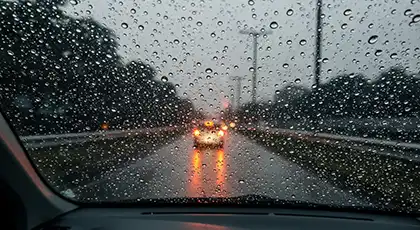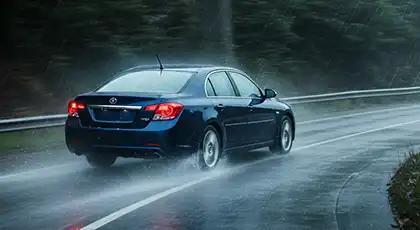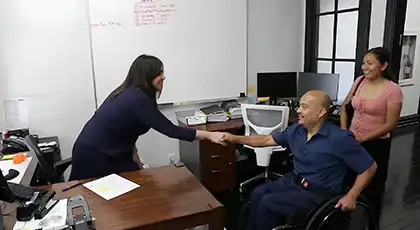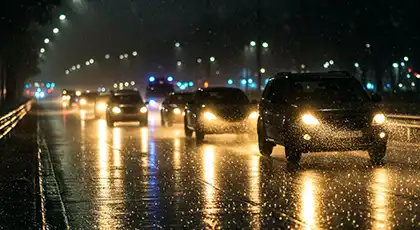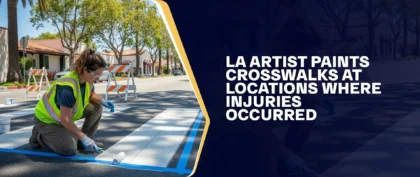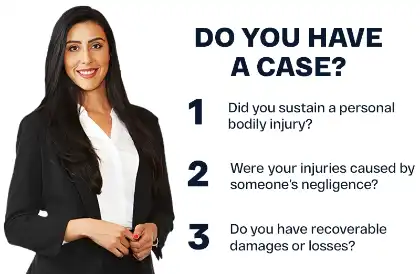Table of Contents
Imagine driving in the rain. You can’t see outside because of the heavy downpour, and your windshield wipers seem not to be working fast enough. Ideally, motorists should reduce their speed to adjust to these conditions. Even a small mistake can lead to a serious rain accident. However, some motorists still drive fast to get off the road quickly.
Wet roads create dangerous driving conditions. Rain can pull oil to the surface of the pavement, making roads even more slippery. Driving too fast raises the risk of hydroplaning, which happens when your tires lose contact with the road. Even a thin layer of water and oil on the road can cause a vehicle to slide out of control.
If you were in a crash during rainy conditions, speak with an injury attorney. At Arash Law, our car accident lawyers understand the legal challenges associated with rain-related accident claims. Our team provides legal representation and a free initial consultation. We conduct thorough investigations and gather evidence to assist you in pursuing compensation for your medical bills, lost income, and other accident-related costs.
Effects Of Driving Too Fast In The Rain
Driving too fast in the rain increases the risk of accidents. High speeds during warm, sunny weather already pose a serious hazard to motorists. Add slick pavement and rain to the equation, and the result could be more catastrophic. Wet roads limit visibility, and speeding leaves you less time to react to sudden changes in traffic.
According to the Federal Highway Administration, approximately 75% of weather-related crashes occur on wet pavement, and nearly half happen during rainfall. Each year, wet road conditions contribute to around 5,700 deaths and over 544,000 injuries nationwide.
Common Types Of Accidents Caused By Driving Too Fast In The Rain
Many drivers speed in the rain when they are exhausted, impatient, or anxious to reach their destination. Speeding through wet pavement can quickly result in serious, and often avoidable, collisions. These are some of the common types of speeding-related accidents in the rain:
- Hydroplaning Spin-Outs — When a vehicle moves too fast over wet pavement, the tires can lose contact with the road surface. This causes the car to slide uncontrollably, often resulting in spin-outs, collisions, or veering into guardrails or other lanes.
- Run-Off Road Collisions — Wet conditions and sharp turns are a dangerous mix. Speeding increases the chances of skidding off the road, especially near curves, exit ramps, or steep grades.
- Intersection Crashes — Drivers approaching intersections too quickly in the rain may be unable to stop in time due to reduced traction. This can lead to crashes with crossing vehicles (T-bone accidents), pedestrians, or traffic poles. Intersection accident attorneys can help victims understand what evidence shows negligence and how the weather may have contributed to the crash.
- Downhill Brake Loss Accidents — Going too fast downhill on a rain-slicked road can overwhelm a vehicle’s braking system. Loss of control while braking downhill may cause rear-end collisions with cars stopped at the bottom or crashes with roadside barriers.
- Splash-and-Swerve Accidents — At high speeds, a vehicle can throw water onto another driver’s windshield or swerve suddenly after hitting a puddle, causing sideswipe crashes with nearby cars or structures.
Speed and rain create a dangerous combination that often results in catastrophic injuries, including traumatic brain injuries, spinal cord damage, and broken bones. Understanding how these accidents happen is important to help prevent future crashes and support a personal injury claim. Suppose another driver’s unsafe speed during rainy conditions caused your accident. In that case, our attorneys can evaluate your case, help gather supporting evidence, and guide you through the legal process of seeking compensation for your injuries and related losses.
Effects Of Rain On Visibility
Rain can significantly reduce visibility, making it more difficult for drivers to see the road, surrounding vehicles, pedestrians, and potential hazards. Light rain can impair vision, while heavy downpours can create near-whiteout conditions. Here’s how rain affects visibility on the road:
- Scattered & Reflected Light — Light emitted by streetlights and other vehicles can scatter when it hits raindrops, creating glare and reducing contrast. Drivers may struggle to judge distances, identify lane markings, or see approaching vehicles.
- The Mandelbaum Effect — In low-visibility conditions like rain or fog, drivers may unknowingly fix their gaze just a few feet ahead of the vehicle instead of scanning the road. Called the Mandelbaum Effect, this visual focusing issue reduces depth perception and limits the driver’s ability to detect hazards in time. It can impair situational awareness and slow reaction times, increasing the risk of a crash.
- Blurry Windshields — Rainwater on the windshield can distort your view of the road, even when wipers are in use. Streaks, smudges, or worn wiper blades can also make it difficult to see clearly through the glass.
- Foggy Windows & Mirrors — Moisture buildup can fog up windshields and side mirrors, creating blind spots and reducing your field of vision. Poor airflow in the vehicle and malfunctioning defoggers can worsen the issue.
- Reduced Night Visibility — Driving at night already limits how far ahead you can see, but rain makes it even worse. Water on the windshield, road surface, or side mirrors distorts light and makes it harder for drivers to see. Headlights may appear dimmer or scatter across the wet road.
If you must drive in the rain, slow down and stay patient. If visibility becomes too poor, pull over safely and wait it out. Your safety is worth the delay.
What Is Hydroplaning, And What Makes It Dangerous?
Hydroplaning, or aquaplaning, occurs when a vehicle’s tires lose traction uncontrollably over a layer of water. It typically happens in wet conditions, especially when the water on the road exceeds one-tenth of an inch in depth. Tires with good tread help channel water away and lower the risk of hydroplaning, but it can still occur if the volume of water is too much for the tires to handle. As a result, hydroplaning reduces a driver’s ability to control the vehicle.
It’s important to understand that hydroplaning doesn’t require heavy rain; it can happen even after a light shower. No matter how shallow or deep the water is, it can reduce traction. Hydroplaning can be scary, but with proper preparation and careful driving, you and your car can stay safe on wet roads.
What Causes Hydroplaning?
Hydroplaning may be one of the serious risks drivers face during rainy weather, but it can also be preventable. By understanding the key factors that cause it, you can make safer driving decisions and help reduce your risk of losing control on wet roads.
Four main factors contribute to hydroplaning risk:
- Road Conditions — The risk of hydroplaning goes up as more water accumulates on the road. Heavy rain, uneven pavement, and poor drainage can create slick surfaces. Even a thin layer of water mixed with oil can create dangerous road conditions. Many drivers underestimate the risk and fail to slow down, which increases their chances of crashing.
- Vehicle Speed — Tires need time to push water out from between the tread and the road. The faster you drive, the harder it is for tires to do this. Hydroplaning can happen at speeds as low as 35 mph, depending on tire tread and how much water is on the road.
- Tread Depth — Tire tread helps move water away so the tire can grip the road. If the tread is worn down, especially below 1/16 of an inch, tires can’t push water away effectively and are more likely to hydroplane. Replacing old or worn tires is key to staying safe in wet weather.
- Vehicle Weight — Heavier vehicles are less likely to hydroplane because their weight helps keep the tires in contact with the road. Even with the same tires, lighter vehicles are more likely to lose traction in wet road conditions.
How To Avoid Hydroplaning
Hydroplaning is one of the common hazards associated with rainy weather. You can take steps to help reduce your risk of losing traction.
Here are simple precautions you can follow to prevent hydroplaning:
- Tire Maintenance — Replace tires when the tread wears out and maintain proper inflation. A good tread helps channel water away from your tires’ contact surface.
- Reduce Speed — Driving too fast in the rain dramatically increases the risk of hydroplaning. Slow down by 30% from the posted speed limit during wet conditions.
- Avoid Standing Water — Water accumulates in road dips and outer lanes. Drive in the middle lanes when possible, where water is less likely to pool.
- Follow Other Vehicles’ Tracks — Vehicles ahead of you displace water, creating a slightly drier path that provides better traction.
- Disable Cruise Control — Manual control allows you to sense changes in road conditions and respond promptly.
- Use Lower Gears — Driving in lower gears (for stick-shift or manual transmission vehicles) provides better stability and control on slippery surfaces.
- Make Gradual Movements — Avoid sudden braking, sharp turns, or quick lane changes that can trigger a loss of traction.
Learning the causes of hydroplaning is as essential as knowing how to prevent it. The simple precautions above will allow you to confidently drive in wet, slippery, or unpredictable conditions.
How To Recover From Hydroplaning
Hydroplaning can occur to any driver, even the careful ones. Knowing how to respond appropriately when your tires skid and lose contact with the road is essential.
Here’s what you can do if your car starts to hydroplane:
- Take a breath and ease off the gas. Don’t panic. Slowly lift your foot off the pedal to let your vehicle slow down on its own.
- Don’t slam the brakes. Hitting the brakes hard can make you skid more. Instead, press them gently and steadily if you need to slow down.
- Steer in the direction your car is going. If you’re sliding, turn your wheel toward the same direction. This can help your tires reconnect with the road.
- Keep a steady grip. Hold the wheel firmly, but don’t overcorrect. Small, smooth movements can help you stay in better control.
- Pull over when it’s safe. Once you regain control, find a safe spot to stop and reset. Take a moment before getting back on the road.
Knowing how to handle hydroplaning can make a big difference. Stay alert, take it slow when the roads are wet, and prioritize safety for yourself and those around you.
Liability For Hydroplaning Accidents
When hydroplaning accidents occur, victims may have the right to pursue compensation from the responsible parties, depending on the situation. Drivers who fail to adjust their speed for wet conditions, misuse cruise control, or neglect proper tire maintenance can be held accountable.
In some cases, road authorities may be held liable for poor drainage, potholes, or other hazards that contributed to the crash. Victims may also be able to file a product liability claim against tire manufacturers for auto defects or a premises liability claim against property owners who failed to address known hazards on private land.
When investigating who’s responsible for your hydroplaning accident, we look at a range of evidence:
- Police Reports & Accident Investigations — These reports offer an official account of the scene, including weather, road conditions, and any citations issued.
- Witness Accounts — Statements from passengers, nearby drivers, or bystanders can help clarify what happened just before the crash.
- Photographic Evidence — Photos of the scene, road surface, vehicle damage, or skid marks can help explain how the accident occurred.
- Expert Analysis or Accident Reconstruction — For more complex cases, we may work with industry specialists who analyze road design, tire condition, and driver behavior to determine what caused the crash.
This type of evidence helps investigators and car accident attorneys determine whether driver error, poor road design or maintenance, or defective products, like tires, played a role in the motor vehicle accident. Each detail helps build a clear picture so insurers, courts, or legal teams can fairly assess liability.
What To Do After A Car Accident In The Rain
Even careful drivers can get hurt when others act carelessly, especially in rainy conditions. If you were in a crash, you’re possibly at home or in the hospital, trying to figure out what to do next. Taking certain steps after the accident may help protect your health and your legal rights.
- Exchange Information If You Haven’t Already — If you were unable to exchange contact or insurance details at the time of the crash, your lawyer can help you obtain this information later through official reports or insurance companies.
- Request a Copy of the Police Report — If law enforcement responded to the scene, they likely filed an official report. This document can be useful for your insurance claim or any legal action.
- Save Any Photos or Notes You Took — If you took pictures or wrote down details at the scene, store them in a safe place. These may include vehicle damage, weather conditions, road hazards, or your account of what happened.
- Follow Up With a Doctor — Some injuries, like soft tissue damage or internal injuries, may not appear right away. Keep track of all medical visits and follow your doctor’s instructions closely.
- Speak with a Lawyer — Consult a car accident injury attorney who can help you understand your legal options. A lawyer can guide you through the claims process and help you seek compensation for medical bills, lost income, and other accident-related costs.
Facing the aftermath of a traffic collision can be challenging, and legal support may help clarify your available options. Call us at (888) 488-1391 or fill out our online contact form. In addition to rain-related accidents, our injury attorneys handle cases involving truck collisions, motorcycle crashes, and pedestrian accidents throughout California.
Frequently Asked Questions About Driving Too Fast In The Rain
Driving in the rain presents unique challenges, especially when speed is involved. Many drivers underestimate how much wet weather can impact road safety, reaction times, and vehicle control. Below are answers to some common questions about driving too fast in the rain.
If you have any legal concerns, contact our lawyers for car accident victims. We offer free initial consultations.
What Is The Appropriate Driving Speed When It Is Raining?
The California Vehicle Code states that drivers must drive reasonably, given the current weather, road, and traffic conditions. For example, when roads are wet, reduce your speed by about one-third to maintain control and lower the risk of hydroplaning. If the usual speed limit is 60 mph, slow down to approximately 40 mph in rainy conditions.
A car may begin hydroplaning as slow as 35 mph, and tires may lose all traction at 55 mph during heavy rain. Driving too quickly on wet roads heightens the risk of losing control and intensifies the severity of crashes.
How Much Does Rain Affect Braking?
Rain reduces traction between your tires and the road, which increases the time and distance it takes to stop. Even if your brakes are in good shape, wet pavement makes it harder for your tires to grip the surface. In heavy rain, brake pads and rotors can also get wet, which may lead to temporary brake failure, fading, or delayed response. This makes quick stops much more difficult.
Because of these factors, stopping distances in the rain can be nearly twice as long as on dry roads. Experts recommend increasing your following distance to at least six seconds when driving in wet conditions. This extra space gives you more time to react and helps prevent rear-end collisions if traffic stops suddenly.
How Can I See Better In The Rain When Driving?
Heavy rain can significantly reduce visibility, but there are actions you can take to improve your ability to see and for others to see you:
- Use Your Low Beams — High beams reflect off the rain and create glare, making it harder to see. Low beams aim downward and do a better job cutting through the weather.
- Keep Your Lights & Windshield Clean — Dust, bugs, and grime can dim your headlights and streak up your windshield. Give your lights and windows a quick clean regularly to help you see the road clearly.
- Turn on Your Wipers & Defrosters — Foggy glass is common when it’s wet outside. Use your defrosters and A/C to clear the windshield, and ensure your wipers are in good shape so you can get the best visibility possible.
- Replace Wipers Regularly — If your wipers are leaving streaks or not working properly, it’s time for a new pair. Replacing them once a year can make a big difference during stormy drives.
How Much Does A Rain Accident Lawyer Cost?
If you’re thinking, “I need a personal injury lawyer, but how much will it cost?” you’re not alone. Many rain accident attorneys, including those at our firm, work on a contingency fee basis. This means you do not owe any attorney’s fees unless your lawyer recovers compensation for you through a settlement or court award.
If your case is successful, our fee is a percentage of the total recovery. The exact rate depends on factors such as the complexity of the case and whether it settles or goes to trial.
Please note: While there are no upfront attorney’s fees, you may still be responsible for certain case-related costs regardless of the outcome. These costs are typically paid from the final settlement or award, but we will explain how this works during your consultation and before you sign any agreement.
Rain-Related Crash? Speak To Car Accident Lawyers For Legal Guidance
Rain makes driving more dangerous, especially when drivers fail to adjust their speed or take road conditions seriously. Slowing down can help you stay safe during a downpour. Wet pavement reduces tire grip, making it harder to stop or steer. Driving at a safe speed helps maintain control and reduces the risk of a crash.
If you sustain an injury in a crash during rainy weather, our team is ready to assist you. Our lawyers for car accident claims examine all factors that may have contributed to the accident, including vehicle speed, road maintenance, drainage problems, and driver behavior. Understanding the cause is essential to building a well-supported legal claim.
Our personal injury lawyers help clients navigate the legal process with clear communication and focused support. We work to help you pursue compensation for your medical expenses, lost income, and other accident-related losses.
If you sustained injuries in a rain-related collision, call AK Law Firm at (888) 488-1391 or complete our “Do I Have A Case?” form here to get a free initial consultation confidentially and with no obligation to hire us. Our team is available to discuss your case and explain your legal options.

